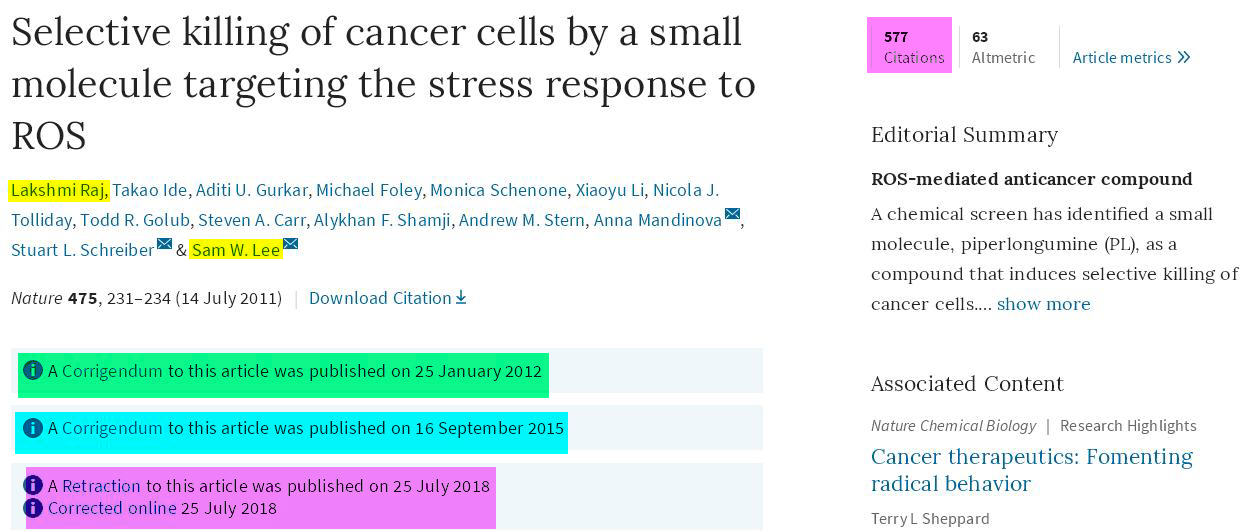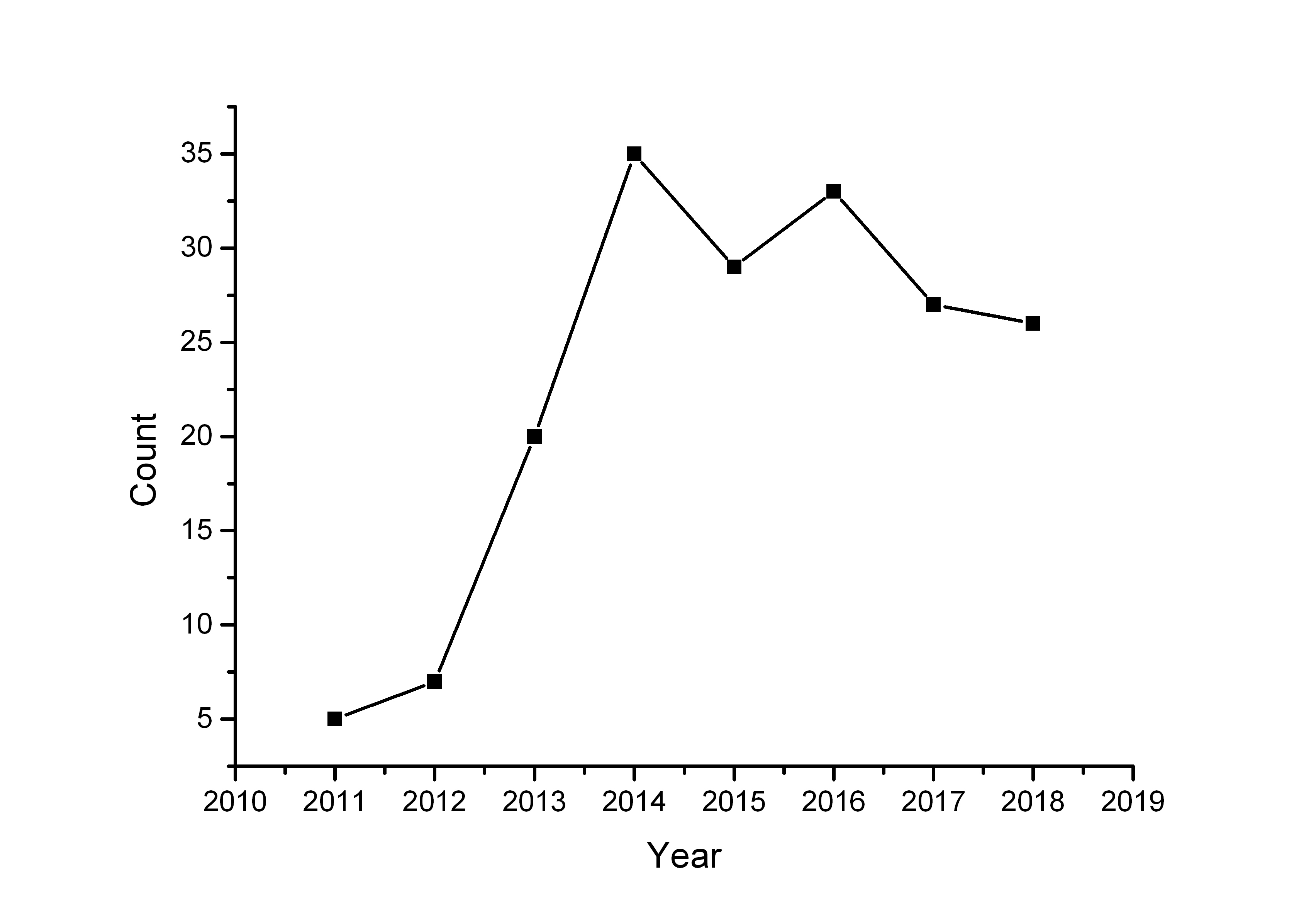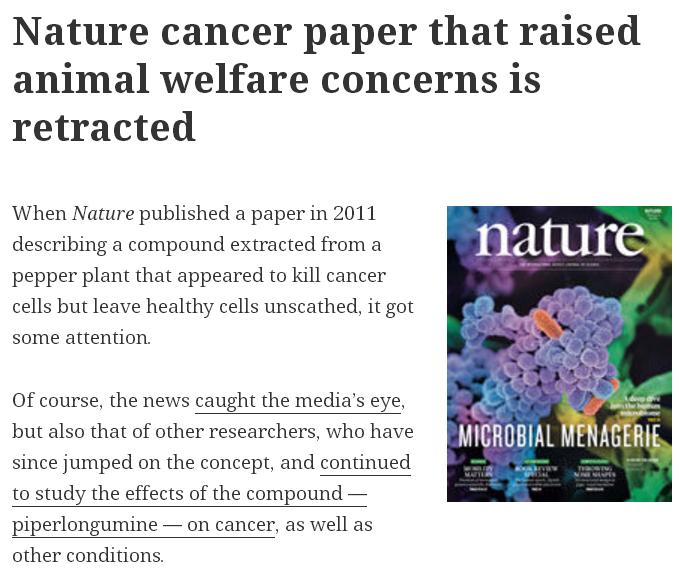博文
Nature撤稿:胡椒提取物抗癌有问题
 精选
精选
|||
Nature撤稿:胡椒提取物抗癌有问题
诸平

Abstract
Malignant transformation, driven by gain-of-function mutations in oncogenes and loss-of-function mutations in tumour suppressor genes, results in cell deregulation that is frequently associated with enhanced cellular stress (for example, oxidative, replicative, metabolic and proteotoxic stress, and DNA damage)1. Adaptation to this stress phenotype is required for cancer cells to survive, and consequently cancer cells may become dependent upon non-oncogenes that do not ordinarily perform such a vital function in normal cells. Thus, targeting these non-oncogene dependencies in the context of a transformed genotype may result in a synthetic lethal interaction and the selective death of cancer cells2. Here we used a cell-based small-molecule screening and quantitative proteomics approach that resulted in the unbiased identification of a small molecule that selectively kills cancer cells but not normal cells. Piperlongumine increases the level of reactive oxygen species (ROS) and apoptotic cell death in both cancer cells and normal cells engineered to have a cancer genotype, irrespective of p53 status, but it has little effect on either rapidly or slowly dividing primary normal cells. Significant antitumour effects are observed in piperlongumine-treated mouse xenograft tumour models, with no apparent toxicity in normal mice. Moreover, piperlongumine potently inhibits the growth of spontaneously formed malignant breast tumours and their associated metastases in mice. Our results demonstrate the ability of a small molecule to induce apoptosis selectively in cells that have a cancer genotype, by targeting a non-oncogene co-dependency acquired through the expression of the cancer genotype in response to transformation-induced oxidative stress3,4,5.
《自然》(Nature) 2011年发表了一篇论文描述从胡椒中提取的一种化合物——荜茇酰胺(Piperlongumine),似乎可以杀死癌细胞,但健康细胞不会受到伤害,使得其受到关注。不仅吸引了许多媒体(caught the media’s eye)的注意,同时也吸引了跟风研究者的眼球,继续研究此化合物(piperlongumine)对癌症的影响,以PubMed数据库为例,相关研究成果数量明显增加。

图1荜茇酰胺(Piperlongumine)相关研究成果的数量变化
![]()
The compound, piperlongumine, comes from the Indian long pepper plant.
但自从 2011年的相关研究结果出现时,研究人员就对一些图有疑虑(concerns about some of the figures ) ——包括一个显示小鼠巨大肿瘤,建议他们在研究过程中经历了不合理的痛苦。《自然》杂志编辑部通过 2012年 和 2015年发布两个漫长的调整通知对此作出回应,还有 一篇社论也承认动物可能“比最初允许经历更多的痛苦和折磨,” 但不会导致撤稿,结果仍然是“有效的和有用的。”然而,几年过去了,到2018年7月25日,《自然》杂志编辑部公布了简短的撤稿通知:
This Letter is being retracted owing to issues with Fig. 1d and Supplementary Fig. 31b, and the unavailability of original data for these figures, which raises concerns regarding the integrity of the figures. Nature published two previous corrections related to this Letter. These issues in aggregate undermine the confidence in the integrity of this study.
大致意思是说,此快报被收回由于图1 d和补充图31 b存在问题,而且这些图形的原始数据是无效用的,这引发了对于所有图形完整性的担忧。尽管《自然》杂志之前发表过两次相关修正,但总体而言这些问题破坏了本研究的完整性。
撤稿通知中解释道,14位作者当中有4位作者不同意撤稿,其中包括第一作者和最后一位作者。根据科睿唯安(Clarivate Analytics’ Web of Science)统计,撤稿论文——Selective killing of cancer cells by a small molecule targeting the stress response to ROS 已经被引用577次, 使其已经成为“高被引论文”,这意味着它在2011年出版的所有论文中被引频次是排名在前1%的。在2015年9月发表校正意见以来它已经被引用了257次。
近年来,这次被撤稿论文署名中的最后一位作者, Sam W. Lee已经收回了另外两篇论文。这本身就是一个不祥之兆。更多细节请注意浏览相关报道:
All retractions are considered on a case-by-case basis, and decisions about whether to retract are made by Nature’s in-house editors, who may seek advice from independent peer-reviewers. Following this process, if the editors deem that a retraction is appropriate, all authors are contacted to seek their assent to the retraction and the retraction statement. Following this, the retraction notice will be published, and any dissenting authors noted in the text of the published version. More information about our retraction policy is available on our website: https://www.nature.com/authors/policies/corrections.html.
We take all issues related to animal welfare very seriously and should we become aware of any breach of our policies in any published paper, we would follow an established process to investigate the issues. More details about Nature’s policies for papers that report experiments with animals are outlined in this editorial: https://www.nature.com/news/protection-priority-1.18354.
When we asked for more specifics about what happened with this particular paper, the spokesperson referred us to the retraction notice:
The issues detailed in the retraction notice do not relate to the previous concerns regarding animal welfare, although all these issues in aggregate undermine the confidence in the integrity of this study.
One reader forwarded us correspondence with the journal dating back to June 2016, in which he raised concerns that supplementary figure 31 contained manipulated images.
We’re also trying to find out more information about why the authors were split in their agreement over the retraction. We contacted coauthor Stuart Schreiber to ask why he agreed with the retraction, and whether it has any impact on a patent related to compounds for cancer therapy, which cites the now-retracted paper; he said he was traveling, and forwarded us to David Cameron, spokesperson for the Broad Institute of MIT and Harvard. Cameron told us:
Although the scientific conclusions of the paper appear sound and its key findings have been extended by other investigators in independent publications, in an abundance of caution all authors who contributed experiments at the Broad Institute of MIT and Harvard support the Nature editors’ recommendation to retract the paper. Because the particular figures referenced were not generated at the Broad, we are not in a position to discuss them.
We emailed co-authors Mandinova and Lee, who co-founded a company around the technology described in the paper — and disagreed with the retraction — but have not received a response. Mandinova and Lee have also filed patents together, including one from 2012 that mentions piperlongumine.
Lee — based at Massachusetts General Hospital — has retracted two papers — a Molecular Cell paper in 2013 due to figure duplication and a Journal of Biological Chemistry paper in 2015, citing “manipulated” data in a figure. He’s also issued at least one other mega-correction, and last year received an expression of concern on another 2011 paper, noting “credible concerns” about the data and conclusions.
https://blog.sciencenet.cn/blog-212210-1126061.html
上一篇:新的研究表明,都灵寿衣是假的,支持其研究撤回
下一篇:Science: 重写我们对胃肿瘤的理解
全部作者的精选博文
全部作者的其他最新博文
全部精选博文导读
相关博文
- • 「观点」深度分析:诺贝尔物理学奖为啥授予AI学者,其物理学基础是什么?
- • Analyze 12 PhiProblem for completeness and consistency(初学者版)
- • Analysis of Philosophy by DIKWP Semantic Mathematics(初学者版)
- • Mathematize The 12 Philosophical Problems with DIKWP(初学者版)
- • Validate Completeness and Consistency of Philosophy(初学者版)
- • Understanding of 12 Philosophical Problems by DIKWP(初学者版)
